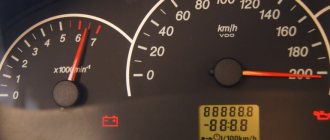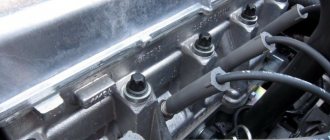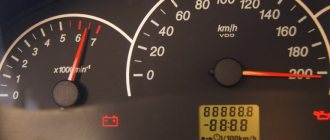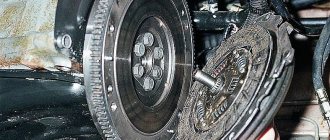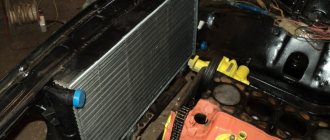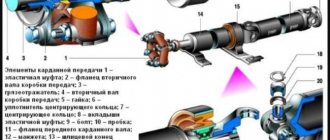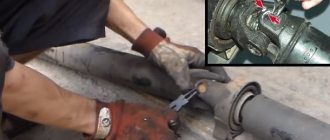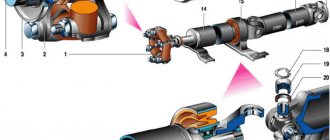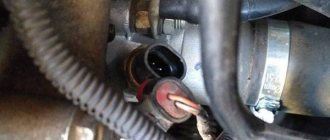All modern cars are equipped with advanced devices for monitoring and recording breakdowns of on-board systems. Standard Lada Vesta error codes are detected and stored in long-term memory until they are read by a third-party device and completely reset. The car itself is a modern car that meets the requirements of advanced standards. The internal components and mechanisms of the car have been modified to the required level of reliability and service life.
On the other hand, motorists often complain about the reliability of electronic components. The on-board electronics malfunction when traveling on unpaved roads or when crossing fords, which causes errors to appear in the systems memory.
List of control system sensors
KSUD - vehicle control system controller, is a complex device with its own operating algorithm. It accumulates signals coming from all vehicle systems. The following types of sensors are installed on Vesta:
| Abbreviation | Decoding |
| DDTV | Air pressure and temperature sensor |
| DTV | Air temperature sensor |
| DBP | Absolute pressure sensor |
| DPKV | Crankshaft position sensor |
| EPA | Electronic gas pedal position |
| DPPA | Accelerator pedal position sensor |
| TPDZ | Throttle position sensor |
| UDC | Control oxygen sensor |
| DTOZH | Coolant temperature |
| DD | Knock sensor |
| DF | Injection phases |
| DSA | Linear speed of the car |
| DDH | Air conditioning system pressure |
When the vehicle is equipped with an automatic transmission, the system additionally receives signals from the transmission. Sensors for transmission oil temperature, end positions of switching and spool mechanisms, and hydraulic unit rotation speed are located directly on the gearbox housing.
Why is the check engine light on, what should I do next?
In a situation where the check light is on or flashing, the driver must listen to the operation of the mechanisms. If there are no failures or noticeable changes in the operation of the engine, there may be an error or failure of the Lada automatic system. Turn off the engine and start it again. If the check engine lights up again, some problems have arisen, and it’s not on for nothing.
Try to cope with the situation
Please note if there are any changes in the vehicle's performance. If the engine is operating in normal mode and the Vesta is driving normally, it does not twitch, there are no knocks, squeaks or noises, check the fuel tank cap
If it is not tightly screwed, or the integrity of the tank itself is compromised, the check may also catch fire.
Other problems are also possible - a malfunction of the oxygen sensor, low-quality fuel, a broken gas pedal, etc.
Operating principle of the controller
The ECM has its own RAM and is capable of storing error codes. It is, in fact, a central processor that controls the actuators. The controller is located in the engine compartment on the left shock absorber support.
Functions:
- car ignition control;
- internal system diagnostics;
- turning on the warning indication on the instrument panel;
- storing error codes in memory;
- emergency warning.
The M86 controller exchanges data with vehicle system sensors by transmitting a signal via a high-speed CAN bus. Due to this, the data is updated every 0.05 seconds, and the car is always under complete control.
The device, like a personal computer, has 2 types of memory:
- constant - ROM;
- operational - RAM.
It is important to remember that the controller is powered by reduced voltage. Any surges are detrimental to microprocessor boards. Therefore, before starting any work, you must disconnect both terminals of the battery.
Recommended Tools to Fix P0343
- To read fault codes - FOXWELL NT301. For advanced troubleshooting, you may need a more advanced scanner.
- Car charger: with battery repair function or simple.
- To check the integrity of the wiring and sensor, use a regular digital multimeter or a more expensive device.
- For an extended check of the signal from the camshaft sensor, use an oscilloscope.
Previous post Error P0300 - what it means, symptoms, causes, diagnosis, elimination
Next entry AlfaOBD diagnostics Fiat Group
Diagnostics
Diagnostics of the Lada Vesta car control system is a simple and understandable process. Part of the work is performed by the ECM, independently determining the current state of the main components. In a situation that requires the driver's attention, it can turn on the "Mil" signal mnemogram. This will mean that the diagnosis needs to be performed soon, but the fault is not critical.
In many ways, the correct behavior of the car depends precisely on the condition of the internal combustion engine. The main deviations that can be mistakenly identified by a diagnostician as an electronics failure are:
- reduction of compression in cylinders;
- presence of air leaks in the air tract;
- violation of gas distribution;
- low fuel quality;
- wear of friction pairs in engine mechanisms.
In each case, it is necessary to investigate the error in detail and check all the systems that contribute to its occurrence.
Instructions for diagnosing VESTA via OBD2 connector with your own hands via a laptop or smartphone
Determine where the OBD2 connector is located
Determine which scanner is suitable for your car
The selection of a scanner (adapter) for LADA VESTA depends on the ECU model, as well as the needs of the diagnostician / car owner.
To select diagnostic equipment, use the calculator: “Selecting a scanner for Lada Vesta”
Download the diagnostic program for the scanner
The diagnostic adapter requires software that can be installed on a laptop or smartphone/tablet. Auto scanners with their own software shell and display do not require software.
To select a program for the adapter, go to the section: “Programs”
Use the instructions and carry out diagnostics
When you purchase an adapter, instructions are included with the adapter. More detailed instructions on diagnostic car scanners and descriptions of their operation are posted in the section: “OBD2 car scanner reviews”
Identify errors and decipher them
Error codes and their interpretation are displayed in the scanner program interface. You can also study the complete database of errors for your car in the section: “OBD2 error codes for Lada Vesta”
Make repairs according to the error code
The unit is repaired according to the decoding of the error (problem) or contact a car service to eliminate a particular malfunction.
Check errors again
Scan Tool Pro - budget multiscanner for Lada Vesta
A good choice for a novice diagnostician
Nowadays there are scanner models with different versions of firmware and chips on sale. Scan Tool Pro with firmware 2022 is the most stable version so far, and also has maximum compatibility with cars manufactured since 2001, including Lada Vesta.
By following the link on the right you can get acquainted with the scanner for autodiagnostics “Scan Tool Pro”. This is an official dealer website that provides a 12 month warranty.
Fault codes
In the process of assessing the technical condition of a car, it is necessary to be able to decipher not only error codes, but also use diagnostic cards. Detailed information about the operating logic of the M86 electronic controller is presented in the operating manual and technical description of the product.
The most common errors that occur during vehicle operation are presented in the table below.
| Error | Meaning |
| P0106 | The pressure sensor is faulty. Air intake section |
| P0101 | There is no signal from the air pressure sensor |
| P0130 | Malfunction of the oxygen sensor in front of the converter |
| P0140 | No common oxygen sensor circuit |
| P0201 | Cylinder No. 1 injector faulty |
| P0202 | Cylinder No. 2 injector faulty |
| P0203 | Cylinder No. 3 injector faulty |
| P0204 | Cylinder no. 4 injector faulty |
| P0217 | Engine temperature limit |
| P0300 | Engines have misfires |
| P0327 | Low signal from knock sensor |
| P0340 | Incorrect signal from the crankshaft position sensor |
| P0363 | Misfire, cylinder forced off |
| P0422 | Low efficiency of the neutralizer, possible clogging |
| P0459 | Canister purge valve malfunction |
| r2103 (2105) | Cylinder failure, misfire |
| P1602 | No power to the controller |
| P1559 | Throttle valve malfunction |
| P1570 | Immobilizer faulty |
| P2101 | Malfunction of the electric damper drive |
| P0901 | Electric clutch malfunction |
| P1303 (13 03) | Extremely low engine speed |
| P2187 | Low gasoline content in the air mixture |
| P2188 | Excessively rich air mixture |
Operating principle of a lambda probe
The main task of the lambda probe is to determine the chemical composition of exhaust gases and the level of oxygen molecules in them. This figure should range from 0.1 to 0.3 percent. Uncontrolled excess of this standard value can lead to unpleasant consequences.
During a standard car assembly, the lambda probe is mounted in the exhaust manifold in the area where the pipes connect, however, sometimes there are other variations in its installation. In principle, a different arrangement does not affect the operating performance of this device.
Today you can find several variations of the lambda probe: with a two-channel layout and a broadband type. The first type is most often found on older cars produced in the 80s, as well as on new economy class models. A broadband sensor is typical for modern mid- and high-class cars. Such a sensor is capable of not only accurately determining the deviation from the norm of a certain element, but also promptly balancing the correct ratio.
Thanks to the hard work of such sensors, the vehicle's operating life is significantly increased, fuel consumption is reduced and the stability of idle speed is increased.
From an electrical engineering point of view, it is worth noting that the oxygen sensor is not capable of creating a uniform signal, since this is prevented by its location in the collector zone, because a certain number of operating cycles may pass in the process of reaching the device with exhaust gases. Thus, we can say that the lambda probe reacts rather to destabilization of the engine, which it subsequently notifies the central unit about and takes appropriate measures.
Features of the manifestation of error P0901
Many motorists have experienced severe clutch failure. The first signs are the blinking of the “gear” icon on the instrument panel. This is followed by uncontrolled shutdown of the transmission. This is very inconvenient for the driver, as he loses the opportunity to even pull over to the side of the road, often not understanding what is happening to the car.
If a similar situation arises on the way, it is recommended to turn off the engine and wait 2-3 minutes for the RAM to reset. After restarting the engine, the error disappears for a short time. This is enough to leave the lane or stop on a traffic island.
Error P0901 is a malfunction of the clutch actuator in 99% of cases and only 1% is a software failure. A licensed car service determines the malfunction quickly enough. Error sign “4b” indicates overheating of the couplings and the entire mechanism. The cost of the actuator ranges from 5,000 to 8,000 rubles. To replace it, you will need to drain the oil from the gearbox, disconnect part of the intake tract and sensors.
As a rule, the first signs of malfunction appear after 60-70 thousand km of intensive mileage during the first two years of operation. You should not downplay the significance of this error, since a faulty actuator will sooner or later lead to the need to replace the entire Vesta clutch mechanism.
Lada Vesta alarm installation with can bus
Ignition switch: +12 – brown ign1 – blue/black starter – red Instrument panel: turns – blue and blue/black handbrake – brown/blue (in the diode)
Driver’s threshold: driver’s limit switch – red/green, we connect the rest to it doors
Under the hood: Tahoe - white/black on the ignition module, the hood tip is in its normal place
Trunk limit switch – we install the connector on the trunk (the limit switch is already in the lock).
central locking .
Robot error indication
The phenomenon of indicating a malfunction in the Lada Vesta robotic gearbox is a common phenomenon even on new cars. But according to the statements of AvtoVAZ designers, it is not a malfunction. The car can continue to be used in normal modes.
The main reason is said to be a “conflict between the box control system and additional equipment,” including the security alarm. Sometimes the alarm appears when the battery is low. During winter periods, cold transmission oil also causes an error.
With frequent stops along the route and the nominal load of the machine, temperature sensors send signals to the security system. The clutch periodically slips briefly, which causes the information indicator to light up. The same situation can arise when driving along a long climb.
As a measure to stabilize the operation of the gearbox, it is recommended to set the shift lever to the “neutral” position in all possible situations: stopping in a traffic jam, parking at traffic lights, waiting for a passenger. During this time, the transmission oil has time to “calm down”, foaming decreases, and the automation begins to operate normally.
The first engine starts after frost are often accompanied by the appearance of an indication. It disappears when you start moving or the oil temperature in the “robot” reaches 40-500C.
On which cars is this problem most common?
The problem with code P0342 can occur on different machines, but there are always statistics on which brands this error occurs more often. Here is a list of some of them:
- Cadillac (Cadillac CTS)
- Chery (Chery A15, Amulet)
- Chevrolet (Chevrolet Aveo, Captiva, Lanos, Lacetti, Optra, Rezzo, Spark)
- Chrysler
- Citroen (Citroen C4)
- Daewoo (Daewoo Lanos, Leganza, Matiz, Nexia, Nubira)
- Ford (Ford F-150)
- Hyundai (Hyundai Accent)
- Opel (Opel Corsa, Frontera)
- Peugeot (Peugeot 308, 3008)
- Skoda (Skoda Octavia, Fabia)
- Toyota
- Volkswagen (Volkswagen Passat)
- VAZ 2110, 2112, 2114, 2115
- Gazelle
- Lada Vesta, Kalina, Niva, Priora
- UAZ
With fault code P0342, you can sometimes encounter other errors. The most common ones are: P0008, P0022, P0335, P0340, P0341, P0343, P0345, P0346, P0347, P0348, P0349, P0365, P0366, P0367, P0368, P0369, P0390, P0391, P0392, P039 3, P0394, P1133, P1396 .
Checking the serviceability of the instrument console
The owner of Vesta can promptly notice deviations in the normal operation of the systems only if the dashboard is in full working order. The built-in automatic diagnostic function can prevent up to 90% of failures. Timely intervention and repairs save money on expensive replacement of components, parts, and mechanisms.
The test is performed automatically every time the engine is started. To assess the serviceability and readiness of devices, it is enough:
- turn off the car ignition;
- press and hold the “up” button on the on-board computer for several seconds;
- Set the ignition to the “On” position.
After this, all the arrows on the instrument panel should deviate to the maximum amplitude, and all indicator lights should light up at full intensity. This indicates the serviceability of the electrical system and its readiness to initiate readings.
